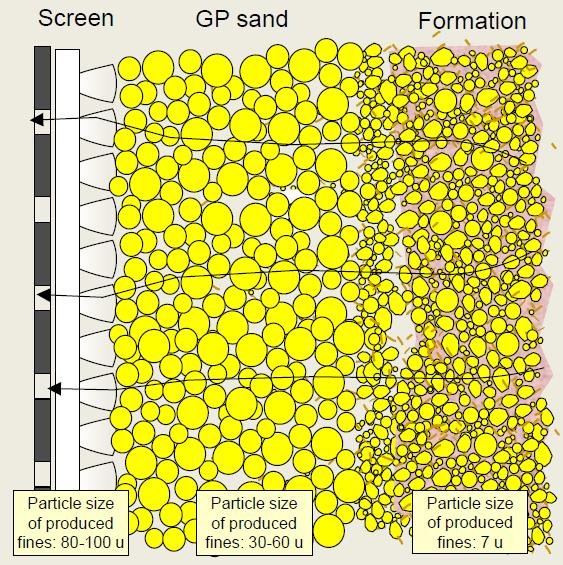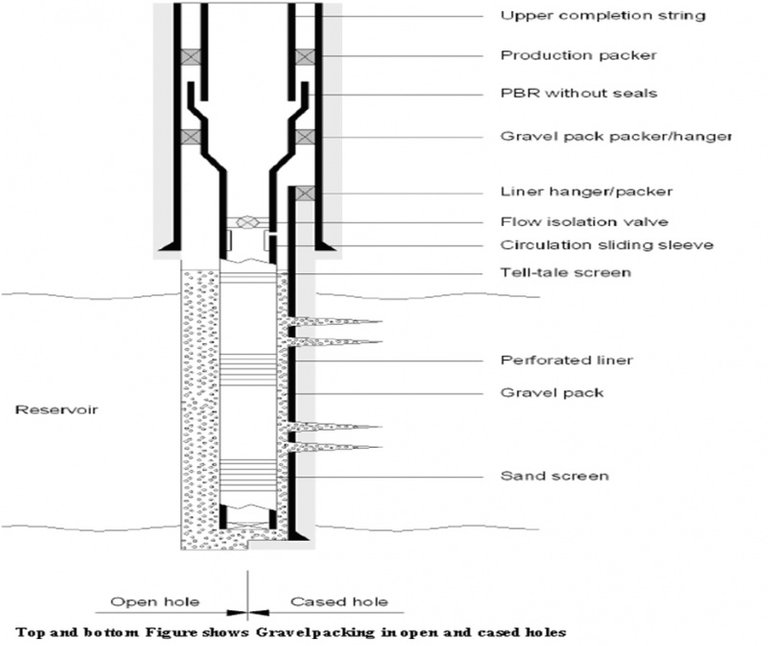Sand Control in a Producing Well
In a producing oil well, there is a tendency for sand to invade the wellbore and this is not healthy for production. In fact, the invasion of production wells by sand is one of the oldest problems faced by oil producing companies and it is also one of the toughest oil well problem to solve. Thus, there is need for sand control practice as sand could cause damage to the sub-surface equipments and other severe operational problems.
By definition, sand control is a technique for preventing or minimizing sand influx into the hydrocarbon flow stream which results when producing from an unconsolidated or weakly consolidated sand formation. In sand control, it is imperative to differentiate between load-bearing solids and solid fines associated with formation fluids which are not part of the mechanical structure of the formation.
Sometimes, it is good to produce fines because if they are not produced out, they will end up plugging or blocking the pore throats or flow channels. As a result of this, production engineers are interested in the control of load-bearing solids during sand control. As a practical matter, it has been suggested that;
All produced solids that are smaller than 90-75 percentile formation are probably interstitial fines.
All produced solids between 90-75 percentile are some of the smaller load bearing solids.
All produced solids between 75-50 percentile are load bearing solids.
What are the Causes of Sand Production?
Producing from an unconsolidated or loosely consolidated formation
Drag forces of flowing fluid which increases with higher flow rates and higher fluid viscosity.
Decline in reservoir pressure which increases compaction forces and may likely disturb the cementation of grains.
Reduced relative permeability to oil, due to increased saturation, which increases pressure drawdown for a given oil production rate.
Reduction in formation strength which is often associated with water production due to dissolving of cement materials
Furthermore, mechanisms or methods of controlling sand production in oil wells are; drag force reduction, bridging sand mechanically and increasing formation strength or bridging sand chemically.
Speaking of "Drag Force Reduction", it is often the cheapest and most effective method of sand control. Fluid production rate causing sand movement is considered as a rate per unit area of permeable formation. Increasing the flow area is a natural outcome of proper well completion operation. Reducing production rate in order to reduce drag forces is not acceptable except on temporary measures.
More so, to increase the flow area, for a fixed fluid production rate, the flow rate per unit area may be reduced by providing clean and large perforations through existing producing section, increasing perforation density, opening increased length of section and creating a conducive path some distance into reservoir by means of packed fracture.
Good completion practice, use of clean completion fluids, and careful selection of perforation charges and perforation conditions can effectively reduce a serious sand production problem.
Bridging Sand Mechanically
Mechanical method involves the use of gravel to hold formation sand in place. This is achieved by using a screen to retain gravel to hold formation sand in place. This is achieved by using to retain formation sand (with no gravel) and using screen with gravel. The main problem is how to retain the formation sand without reducing well productivity.
Sand production in an oil well are seriously detrimental to the short-long-term productivity of the well. Although a few oil wells sometimes experience manageable sand production, in most cases, attempting to manage sand production over the life of the well is not the best option. Hence, oil companies should invest more in preventing sand production.
References
http://www.oilfieldwiki.com/wiki/Sand_control
https://petrowiki.org/Sand_control
https://www.onepetro.org/conference-paper/SPE-150810-MS
https://en.m.wikipedia.org/wiki/Completion_(oil_and_gas_wells)



Thanks for your contribution to the STEMsocial community. Feel free to join us on discord to get to know the rest of us!
Please consider supporting our funding proposal, approving our witness (@stem.witness) or delegating to the @stemsocial account (for some ROI).
Please consider using the STEMsocial app app and including @stemsocial as a beneficiary to get a stronger support.